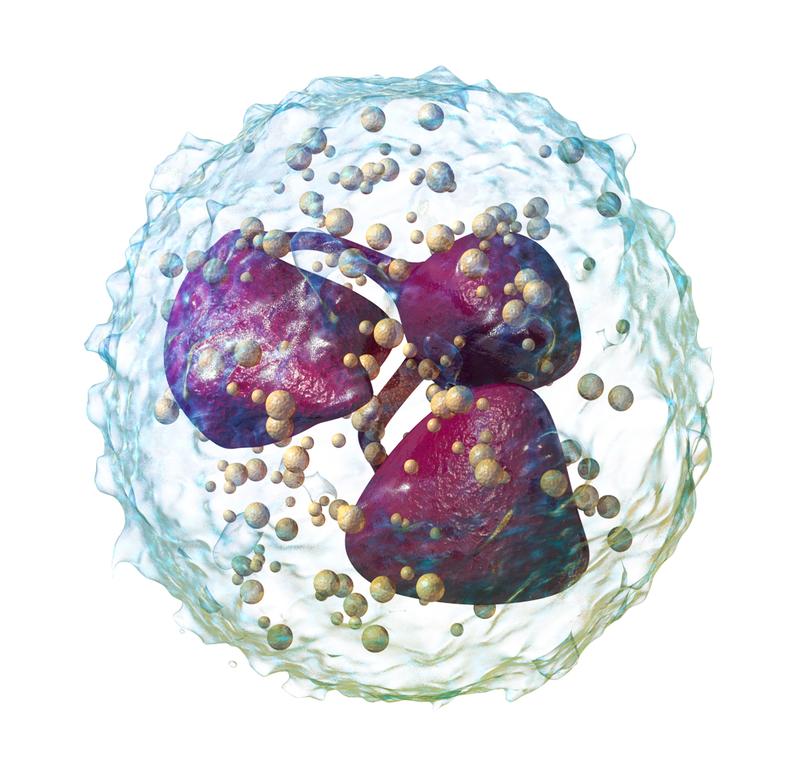May 15, 2025
Tag Archives: neutrophil
Studies Highlight Prognostic Value of Neutrophil-to-Lymphocyte Ratio in MPNs
November 14, 2024
Author(s): Mary Caffrey
Two studies published this month are pointing to the value of the neutrophil-to-lymphocyte ratio (NLR) in forecasting either thrombosis or mortality risk in different myeloproliferative neoplasms (MPNs).1,2
Neutrophil | Image: Blausen Medical 2014

This inflammatory biomarker has emerged as an indicator due to the behavior of neutrophils in MPNs; they are known to produce cytokines when activated and to interact with tissue macrophages and dendritic cells, according to authors of a November 6, 2024, study in Blood Cancer Journal that explored NLR as a prognostic indicator of mortality in polycythemia vera (PV).1
These authors, from several institutions in Italy, analyzed the NLR in 1508 patients with PV and concluded that those with an NLR of at least 5 “were generally older, had a longer disease history, and had higher cardiovascular risk factors, more arterial thrombosis, and more aggressive blood counts, indicating a more proliferative disease.”
This was a prospective study based on patients enrolled in the European Collaboration on Low-Dose Aspirin in Polycythemia Vera (ECLAP) trial, a randomized study to assess the risk/benefit ratio of low-dose aspirin in PV.3
The authors of the new study analyzed data from the 151 deaths (10%) that occurred among the study population, and found an inverse relationship between lymphocyte counts and mortality risk, while also finding that higher lymphocyte counts were associated with a lower risk of death. Their data indicated that a higher NLR correlated with an increased risk of death.1
Thus, these authors concluded that NLR was an accurate predictor of mortality, and those patients with a ratio of at least 5 had worse overall survival with twice the mortality rate of those with a ratio less than 5.1
Previous venous thrombosis was also a strong predictor of death, they wrote.
Findings in Cancer. These findings were consistent with results published November 12, 2024, in Cancer, the official journal of the American Cancer Society, which found a relationship between NLR value at diagnosis and a risk of thrombotic events later on.2 Although this second study was a retrospective study involving fewer patients (473) with essential thrombocythemia (ET), the results also found a predictive value for NLR.
Authors in Cancer, from the University of Milan, reported a total of 78 thrombotic events among the 473 patients, for an incidence rate of 1.8 events per 100 patients/year. This analysis found that an NLR value of at least 4 at diagnosis was associated with a higher cumulative thrombotic risk (HR, 2.05; 95% CI, 1.29-2.28; P = .0001), as well as having diabetes and hypertension.2
Neutrophil-to-lymphocyte ratio as a prognostic indicator of mortality in Polycythemia Vera: insights from a prospective cohort analysis
Tiziano Barbui, Alessandra Carobbio, Arianna Ghirardi, Francesca Fenili, Maria Chiara Finazzi, Marta Castelli, Alessandro M. Vannucchi, Paola Guglielmelli, Alessandro Rambaldi, Naseema Gangat & Ayalew Tefferi
Abstract
We analyzed the neutrophil-to-lymphocyte ratio (NLR) in 1508 patients with PV and found that those with an NLR ≥ 5 were generally older, had a longer disease history, and had higher cardiovascular risk factors, more arterial thrombosis, and more aggressive blood counts, indicating a more proliferative disease. NLR was an accurate predictor of mortality, with patients with NLR ≥ 5 having significantly worse overall survival and more than twice the mortality rate compared to those with NLR < 5. Multivariable models confirmed that increasing age, previous venous thrombosis and NLR ≥ 5 were strong predictors of death, further influenced by cardiovascular risk factors. We examined the interaction between NLR and the number of cardiovascular risk factors and found a progressive trend of increased mortality risk for NLR values ≥ 5 in addition to the presence of more than one risk factor. In conclusion, patients with NLR ≥ 5 require careful monitoring and management of cardiovascular risk factors because they increase mortality when associated with progressive levels of NLR.
High Neutrophil Ratio as a Thrombosis Predictor in Myeloproliferative Neoplasms
July 24, 2024
The following is a summary of “Predictive significance of high neutrophil ratio for thrombosis in myeloproliferative neoplasms: JSH-MPN-R18 subanalysis,” published in the July 2024 issue of Hematology by Nagaharu et al.
A nationwide study was conducted to identify clinical features of thrombosis in patients with myeloproliferative neoplasms to inform risk-based treatment strategies.
Researchers conducted a retrospective study to determine which complete blood count (CBC) parameters predicted thrombosis in patients with myeloproliferative neoplasms.
They investigated patients from JSH-MPN-R18, focusing on essential thrombocythemia (ET; n = 1152) and polycythemia vera (PV; n = 456). Using Welch’s T-test, the CBC parameters were compared with those with or without thrombotic events. Statistical analyses were conducted with R software.
The results showed that 74 patients with ET experienced thrombotic events. In multivariate analysis, patients with ET and thrombosis had a slightly but significantly higher neutrophil ratio compared to those without thrombosis (P<0.05). The absolute neutrophil count (aNeu) emerged as a valuable predictor for thrombosis in patients with low-risk according to the revised International Prognostic Score of Thrombosis for ET. Among patients with PV, those with thrombosis had notably higher hematocrit and aNeu levels than those without thrombosis. Additionally, the neutrophil ratio was slightly but significantly higher in patients with ET with thrombosis, potentially reflecting a greater JAK2 V617F allelic frequency, though was not detailed in JSH-MPN-R18.
